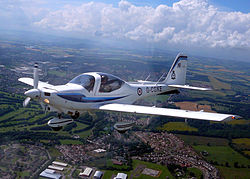| Air Training Corps | |
|---|---|
 | |
| Active | 1941 – present |
| Country | |
| Branch | |
| Type | Volunteer youth organisation |
| Role |
|
| Size |
|
| Part of | Royal Air Force Air Cadets |
| Headquarters | RAF Cranwell |
| Nickname | ATC |
| Patron | The Princess of Wales [1] |
| Motto | Venture Adventure |
| March | The Air Cadets March |
| Anniversaries | ATC Sunday (First Sunday of February, celebrating the formation of the ATC) |
| Website | www.raf.mod.uk/aircadets |
| Commanders | |
| Commandant Air Cadets | Air Commodore Allen Lewis [2] |
| Warrant Officer RAFAC | Warrant Officer Donna Hall |
| Honorary Ambassador | Wing Commander Emma Wolstenholme [3] |
| Air Commodore-in-Chief | The Princess of Wales |
| National Chair | Mr S.J. Ensor [4] |
| National Chaplain | Reverend Gareth Jones [5] |
| Insignia | |
| Ensign |  |
| Aircraft flown | |
| Trainer | |
| UK military cadet forces Military component of the youth organisations in the United Kingdom |
|---|
The Air Training Corps (ATC) is a British volunteer youth organisation; aligned to, and fostering the knowledge and learning of military values, primarily focusing on military aviation. Part of the Royal Air Force Air Cadets (RAFAC), the ATC is sponsored by the Royal Air Force (RAF) and the wider Ministry of Defence (MoD). The majority of Air Training Corps staff are volunteers, though some staff are paid for full-time work; [6] including Commandant RAF Air Cadets, who is a Royal Air Force officer as part of a Full Term Reserve Service commitment. [7] In addition to the Commandant, who is responsible for the organisation’s uniformed activities, RAFAC also has a National Chair, who serves as the senior representative of the trustee pillar; the current incumbent is Mr Stuart Ensor OBE [8] [9] .
Contents
- History
- Foundation
- Air Defence Cadet Corps
- Air Training Corps
- Investigation into sexual abuse
- Air Cadet Organisation
- Structure and organisation
- Regions
- Wings
- Governance
- National
- Local
- Civilian committees
- Culture
- Aims and motto
- Oath
- Ensign
- Uniform
- Squadron insignia
- Activities
- Corps-wide trophies
- Air Training Corps ranks
- Cadet classification syllabus
- Specialist Instructor and Leadership Qualifications
- Adult staff and ranking
- Officers
- Ambassador to the Air Cadets
- Air Commodore-in-Chief
- NCOs and WOs
- Staff (adult) ranks pre-December 2017
- Chaplains
- See also
- Notes
- References
- External links
Members of the Air Training Corps are known as Air Cadets, which is often interchanged with the term 'ATC cadets'. Although many ATC cadets subsequently go on to join the Royal Air Force, or the other branches of the British Armed Forces (or have the desire to do so), the ATC is not a recruiting organisation for its parent service (the Royal Air Force). [10]
Activities undertaken by the Air Training Corps include sport, adventure training (such as walking and paddle-sports), ceremonial drill, rifle shooting, fieldcraft, air experience flights in both powered aircraft and sail-plane gliders, and other outdoor activities, as well as educational classification training. Week-long trips, or 'camps' to RAF stations, along with other camps offering adventure training or music, allow the opportunity for cadets to gain a taste of military life, and often some flying experience in RAF gliders and RAF training aircraft such as the Grob G 115, [11] an aerobatic-capable elementary flying training aircraft, known in UK military service as the Tutor T1. The Viking T1 glider is used to train cadets on gliding the manufacturer name for the Viking T1 is the Grob G103a Twin II, manufactured by Grob. [12]


As of 1 April 2023 [update] , the ATC strength is 34,070 cadets (30% female) and 9,190 adult volunteers (30% female). [13]











































